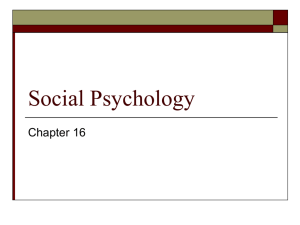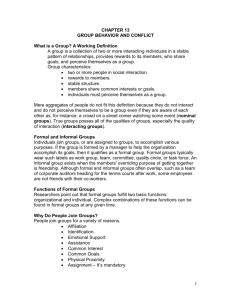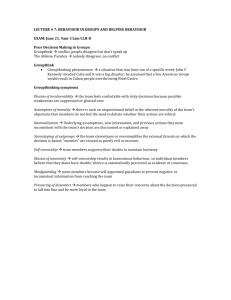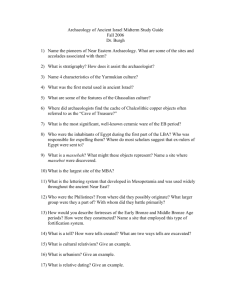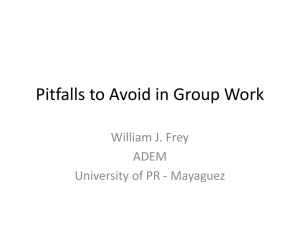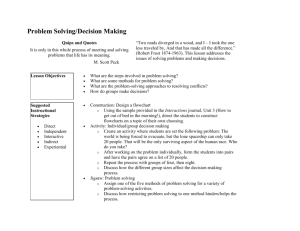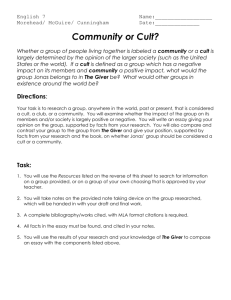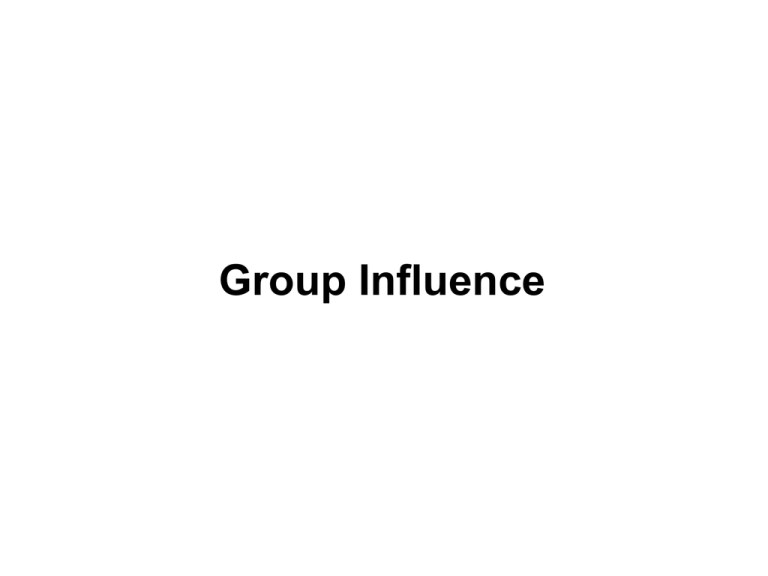
Group Influence
Group: Two or more people who, for longer
than a few moments, interact with and influence
one another and perceive one another as “us”.
I. Social Facilitation versus Social Hindrance
A. Social Facilitation: an individual’s tendency to perform
better on an easy task or well learned task when in the
presence of other people than when performing that task alone.
B. Social Hindrance: an individual’s tendency to perform worse
on a difficult task or a task that is not well learned when in the
presence of other people than when performing that task alone.
1) Zajonc… arousal and the task at hand.
Social Facilitation
Social Hindrance
Playing Pool
Cockroaches too?!
Offices versus Cubicles
II. Crowds
A. Human Territoriality: when a specific space is marked out
and defended against intrusion from others.
1) Primary territories are places over which the occupant
has exclusive control.
2) Secondary territories are areas shared with others but
over which regular users have considerable control.
3) Public territories are uncontrolled areas that are used
by whoever is the first to arrive.
Home Court Advantage
III. Social Loafing: the tendency for people to
exert less effort when they pool their efforts
toward a common goal than when they are
individually accountable.
Cheering for
your team
Tug-of-war
So what is the typical rate of decline in terms of individual
effort matched with group size?
Cultural and Sex Differences
Social Loafing by the Beatles
A. Why do we loaf?
1) The Collective Effort Model: people get lazy if they don’t expect
their efforts to lead to personally valued outcomes or if they don’t
think their efforts will be instrumental in obtaining those outcomes.
2) The Free Ride Effect: when they can get away with it, people try to
benefit from the efforts of others.
3) The Sucker Effect: when people believe that they are getting taken
advantage of, they exert less effort because they suspect others
may be taking a free ride.
B. Social loafing can be reduced.
1) Cohesion: “we feeling”; the extent to which members of a group are
bound together, such as through identification.
2) Evaluation: when people believe they’ll be individually evaluated on
their performance, they’ll work harder than they will if they were not
being evaluated.
C. Social Compensation: when cohesion and evaluation are
absent, a person who cares about the quality of the group
product will expend greater effort to compensate for others in
the group who are performing inadequately.
IV. Deindividuation: the feeling of anonymity
and reduced sense of ourselves as individuals
that can occur when people are in groups
and/or anonymous; it leads to a loosening of
normal constraints on behavior and an increase
in impulsive and deviant acts.
A. Group Size: the larger the group the more its members lose
self-awareness and become willing to commit atrocities.
B. Physical Anonymity: being anonymous makes one less
self-conscious, more group-conscious, and more responsive
to cues present in the situation, whether negative or positive.
Trick or Treat!
Role-Playing
Deindividuation and Intimacy
V. Group Polarization: Group-produced
enhancement of members’ preexisting
tendencies (typically via discussion); a
strengthening of the members’ average
tendency, not a split within the group.
So group polarization is NOT what’s referred to as a…
A. Schism: the splintering of a group into distinct factions
following an ideological rift among members.
B. Why does group polarization happen?
1) Social Comparison Theory: group polarization occurs
because we want our position to be consistent with the
group we compare ourselves to.
2) Persuasive Arguments Theory: the position that has the
largest number of arguments supporting it will pull group
members further along in the direction of those arguments.
3) Repeated Expressions Theory: having people in a group
individually ruminate or state their positions over and over
again will also move the group towards greater polarization.
VI. Groupthink: mode of thinking that people
engage in when agreement-seeking becomes
so dominant in a cohesive in-group that it tends
to override a realistic appraisal of alternative
courses of action.
A. Key Characteristics of Groupthink
1) An illusion of invulnerability
2) Unquestioned belief in the group’s morality
3) Closed-mindedness
4) Self-censorship and conformity pressure
B. Black Sheep Effect: the tendency of an in-group to treat
or evaluate a nonconforming member of its own more harshly
than a similarly nonconforming out-group member.
C. Why does groupthink happen?
1) Group Locomotion Hypothesis: if you feel that going
along with your group will help it to achieve its goals,
you conform.
2) Consistency Theory: cognitive dissonance arises if you
disagree with a group you like. So, you conform to reduce
dissonance.
3) Hedonistic Hypothesis: you conform to either decrease
pain or increase pleasure.
VII. Group Problem Solving
A. Brainstorming in groups, especially large groups, can
lead to a number of problems…
1) Social Loafing
2) Conformity due to normative influence
3) Production Blocking: losing one’s ideas while waiting
for one’s turn to speak.
B. Most productive sequence for group problem solving…
1) Have a brief group brainstorming session to prime
ideas and the creative process.
2) Have all group members then separate and work
alone to generate ideas for solving the problem at hand.
3) Reconvene allowing each member to share the ideas
he or she privately generated.
4) Discuss, weigh options, and eventually choose a
course of action.
VIII. Minority Influence:
The Antithesis of Groupthink
A. Minority Influence: those who hold an unpopular opinion
eventually change the attitudes of those who hold the majority
opinion.
B. What facilitates the influence of minorities?
1) Self-Confidence
2) Defections from the Majority: a minority person who
defects from the majority is more persuasive than a
consistent minority voice.
C. Is Leadership Minority Influence?
1) Task leadership: organizes work, sets standards, and
focuses on goals.
2) Social leadership: builds teamwork, mediates conflict,
and offers support.
3) Transformational leadership: leadership that, enabled by
a leader’s vision and inspiration, exerts significant influence.
IX. Cults
Cult: a group typically characterized by
(1) distinctive rituals and beliefs related to its
devotion to a god or a person (2) isolation from
the surrounding “evil” culture (3) a charismatic leader.
A. Four Stages of Indoctrination
1) Softening-up Stage: the victim is showered with affection and praise
during moments of weakness.
2) Compliance: the victim starts testing the waters of the cult’s practices.
3) Internalization: the victim starts to really believe the ideas of the cult.
4) Consolidation: the victim demonstrates unconditional allegiance to
the cult.
What facilitates the movement from stage 1 all the way to
stage 4? Key Factors…
B. People who are lost in life, looking for meaning, suffered
a major loss, etc., are easy targets for cults.
C. Individuals are more likely to conform to a cult when
their indoctrination into the cult is difficult or intense.
D. Using the Foot-in-the-Door tactic: Gradual Induction
E. Cult leader’s credibility and attractiveness are
established.
F. Sending members out to proselytize the unredeemed.
G. Distracting members from thinking “undesirable”
thoughts… counter-arguments.
H. Fixating members’ vision on a phantom.

